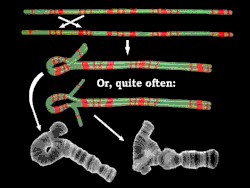
Back انقلاب صبغي Arabic Inverzija (genetika) BS Inversió genètica Catalan Inversion (Genetik) German Inversión cromosómica Spanish وارونگی کروموزومی Persian Inversión cromosómica Galician Inverzió (genetika) Hungarian Inversione (cromosoma) Italian ინვერსია (ბიოლოგია) Georgian
An inversion is a chromosome rearrangement in which a segment of a chromosome becomes inverted within its original position. An inversion occurs when a chromosome undergoes a two breaks within the chromosomal arm, and the segment between the two breaks inserts itself in the opposite direction in the same chromosome arm. The breakpoints of inversions often happen in regions of repetitive nucleotides, and the regions may be reused in other inversions.[1] Chromosomal segments in inversions can be as small as 1 kilobases or as large as 100 megabases.[2] The number of genes captured by an inversion can range from a handful of genes to hundreds of genes.[3] Inversions can happen either through ectopic recombination between repetitive sequences, or through chromosomal breakage followed by non-homologous end joining.[4]
Inversions are of two types: paracentric and pericentric. Paracentric inversions do not include the centromere, and both breakpoints occur in one arm of the chromosome. Pericentric inversions span the centromere, and there is a breakpoint in each arm[5].


Inversions usually do not cause any abnormalities in carriers, as long as the rearrangement is balanced, with no extra or missing DNA. However, in individuals which are heterozygous for an inversion, there is an increased production of abnormal chromatids (this occurs when crossing-over occurs within the span of the inversion). This leads to lowered fertility, due to production of unbalanced gametes. Inversions do not involve either loss or gain of genetic information; they simply rearrange the linear DNA sequence.
- ^ Corbett-Detig RB, Said I, Calzetta M, Genetti M, McBroome J, Maurer NW, et al. (December 2019). "Fine-Mapping Complex Inversion Breakpoints and Investigating Somatic Pairing in the Anopheles gambiae Species Complex Using Proximity-Ligation Sequencing". Genetics. 213 (4): 1495–1511. doi:10.1534/genetics.119.302385. PMC 6893396. PMID 31666292.
- ^ Porubsky D, Sanders AD, Höps W, Hsieh P, Sulovari A, Li R, et al. (August 2020). "Recurrent inversion toggling and great ape genome evolution". Nature Genetics. 52 (8): 849–858. doi:10.1038/s41588-020-0646-x. PMC 7415573. PMID 32541924.
- ^ Wellenreuther M, Bernatchez L (June 2018). "Eco-Evolutionary Genomics of Chromosomal Inversions". Trends in Ecology & Evolution. 33 (6): 427–440. doi:10.1016/j.tree.2018.04.002. PMID 29731154. S2CID 22051290.
- ^ Huang K, Rieseberg LH (2020). "Frequency, Origins, and Evolutionary Role of Chromosomal Inversions in Plants". Frontiers in Plant Science. 11: 296. doi:10.3389/fpls.2020.00296. PMC 7093584. PMID 32256515.
- ^ Kirkpatrick M (September 2010). "How and why chromosome inversions evolve". PLOS Biology. 8 (9): e1000501. doi:10.1371/journal.pbio.1000501. PMC 2946949. PMID 20927412.
© MMXXIII Rich X Search. We shall prevail. All rights reserved. Rich X Search